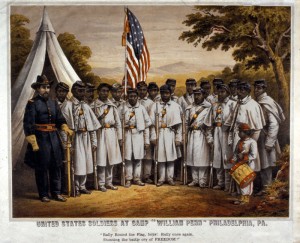We interrupt this Spring Break to note that on this day, 150 years ago, Texas officially became a Confederate state. That makes this as good a time as any to reflect on the question: Why did Texas secede?
First, it is worth noting that secession had been brewing for months before March 1, 1861, when the final deed was struck. As today’s post on the New York Times “Disunion” blog notes, Unionists in Texas were an embattled group that did not put up much of a fight to keep Texas in the Union. On February 16, 1861, U.S. General David Twiggs and all the federal troops under his command quickly surrendered under pressure from hundreds of armed secessionists who surrounded him in San Antonio. Two days later, without a shot being fired, he and his troops filed out of Texas, leaving it to the Confederacy. Only two weeks before Twiggs’ surrender, a secession convention in Austin had adopted two documents: an ordinance of secession from the Union (pictured above), and a declaration of the state’s causes for secession. And only two weeks after Twiggs’ surrender, the deed was officially done.
If you had happened to be in San Antonio two weeks ago, you might have seen a reenactment of Twiggs’ surrender. As a recent article in the Texas Observer reported, this reenactment–organized partly by the Sons of Confederate Veterans–takes place every year on the plaza of the Alamo. But as the article also notes, if you had asked the reenactment’s organizers about the reasons for Texas’s secession, you probably wouldn’t have heard much about slavery. One of the past organizers interviewed by the Observer even said bluntly that “the South was fighting for states’ rights,” not about slavery per se.
In fact, however, the Declaration of the Causes which Impel the State of Texas to Secede from the Federal Union, adopted by the secession convention in Austin on February 2, 1861, returns again and again to the issues of slavery and race. First, the declaration argues that Texas only agreed to join the Union in 1845 on the understanding that “the institution known as negro slavery–the servitude of the African to the white race within her limits” would be protected and allowed to “exist in all future time.” According to the secessionists who voted Texas out of the Union, the federal government was now advancing schemes that would lead to the “ruin of the slave-holding States.” As a result, said the secessionists, Texans wanted to make their own views clear:
We hold as undeniable truths that the governments of the various States, and of the confederacy itself, were established exclusively by the white race, for themselves and their posterity; that the African race had no agency in their establishment; that they were rightfully held and regarded as an inferior and dependent race, and in that condition only could their existence in this country be rendered beneficial or tolerable.
That in this free government all white men are and of right ought to be entitled to equal civil and political rights; that the servitude of the African race, as existing in these States, is mutually beneficial to both bond and free, and is abundantly authorized and justified by the experience of mankind, and the revealed will of the Almighty Creator, as recognized by all Christian nations; while the destruction of the existing relations between the two races, as advocated by our sectional enemies, would bring inevitable calamities upon both and desolation upon the fifteen slave-holding States.
In short, secessionists in Texas made clear, in their own words, that they were seceding to preserve the institution of slavery permanently and to maintain a government for whites only.
One question worth pondering in the coming weeks: if this is what Texan secessionists went on record to say when they left the Union, what did Dick Dowling think about secession? In last week’s blog post, Ross raises the question of what Dowling was fighting for at Sabine Pass. How would you answer that question? Have you found evidence in your research that might indicate where Dowling stood?
At the very least, we know that Dowling was a fervent supporter of secession from very early on. He was one of over two hundred people who signed a petition in November 1860, immediately after Lincoln’s election, calling for a public meeting in Houston that later voted to ask the governor to convene the legislature. When Governor Sam Houston, a Unionist, refused to do that, secessionists took matters into the own hands by planning the February 1861 secession convention. Dowling’s rapidly enlisted after that convention called for troops, and while he was not present at Twiggs’ surrender, he was part of a group of militia companies dispatched to the lower Rio Grande Valley to force a federal army post there to surrender, which it did not long after Twiggs folded.
All of this happened before shots had been fired on Fort Sumter. There was no immediate threat of federal armies marching on Texas; on the contrary, the few federal troops in Texas were marching out. But in this crucial month, it was clear that Dowling stood on the side of the secessionists. That raises several questions worth thinking about as we continue to talk about Dowling: In the absence of evidence to the contrary, is it safe to assume he agreed with the “causes” for secession outlined in the convention’s declaration? Is there evidence that other motives played a role in his thinking? When Texas secessionists spoke about political equality for all white men, would they have included Irish Catholics like Dowling?
And here’s another question: regardless of what Dowling personally thought, what do Texas’ secession documents tell us about the kind of society Texas would have been if his side had succeeded? If Dowling’s victory at Sabine Pass had not been an isolated victory, but instead had succeeded in keeping Texas permanently outside the Union, what would Texas have looked like? If it would have looked at all like the society of permanent slavery and white supremacy envisioned in the Declaration, is it even possible to consider Dowling a hero?
Feel free to post comments on this post if you’d like to weigh in on these questions. I have been enjoying working through your Library Assignment posts. As Mercy notes in her latest round-up, your classmates have written some great posts that you should read. In the meantime, have a great Spring Break, and I’ll see you in a week.





